
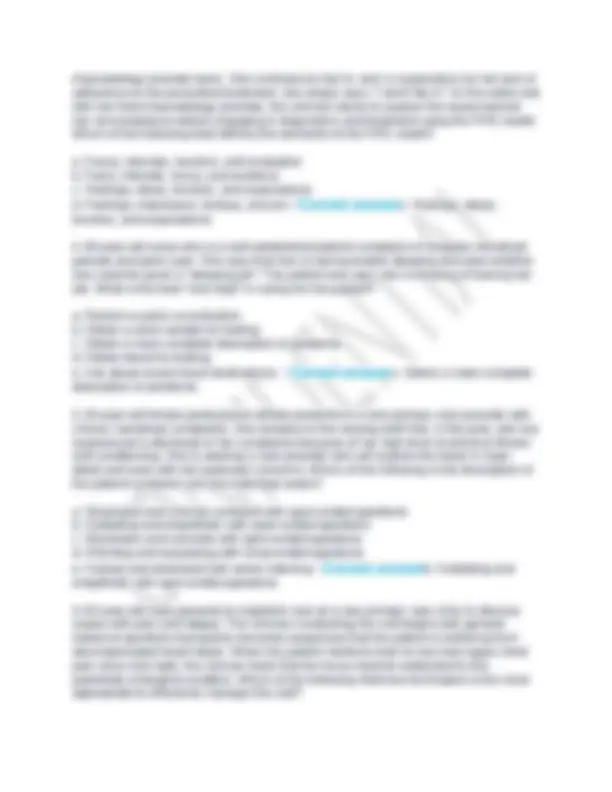
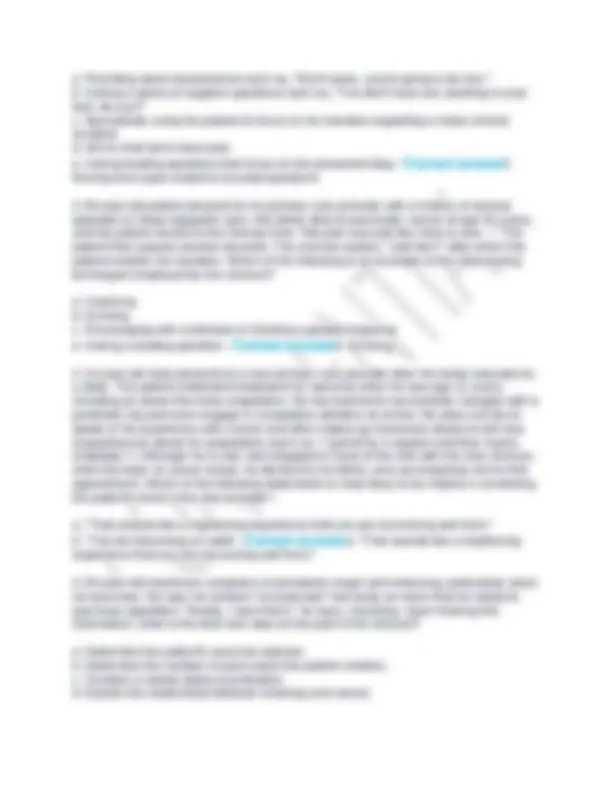
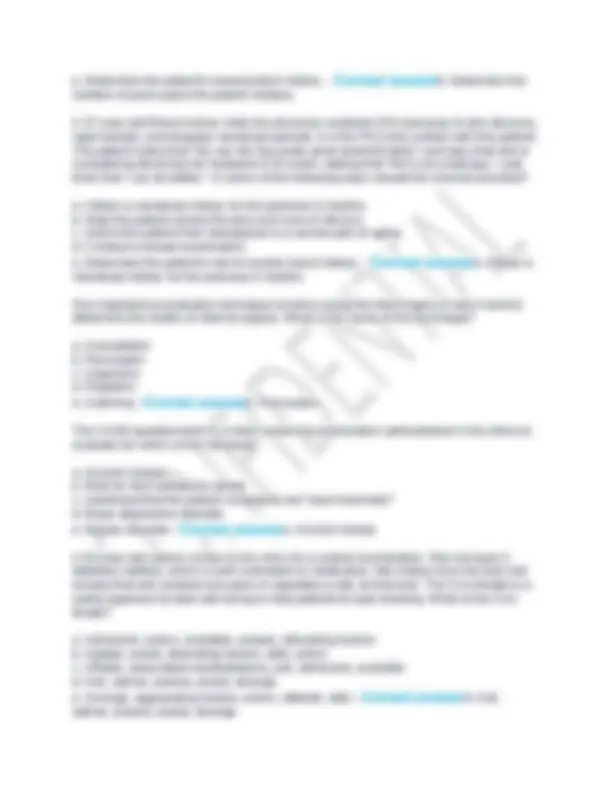
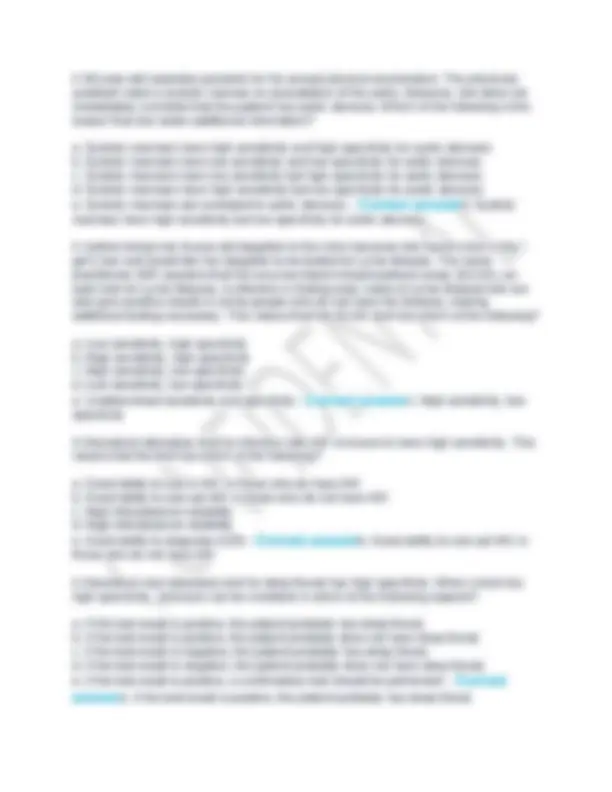
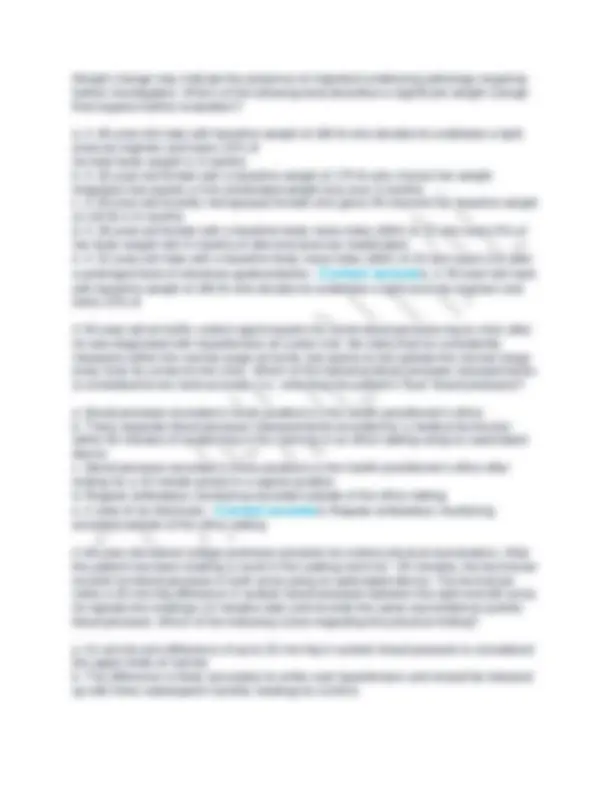
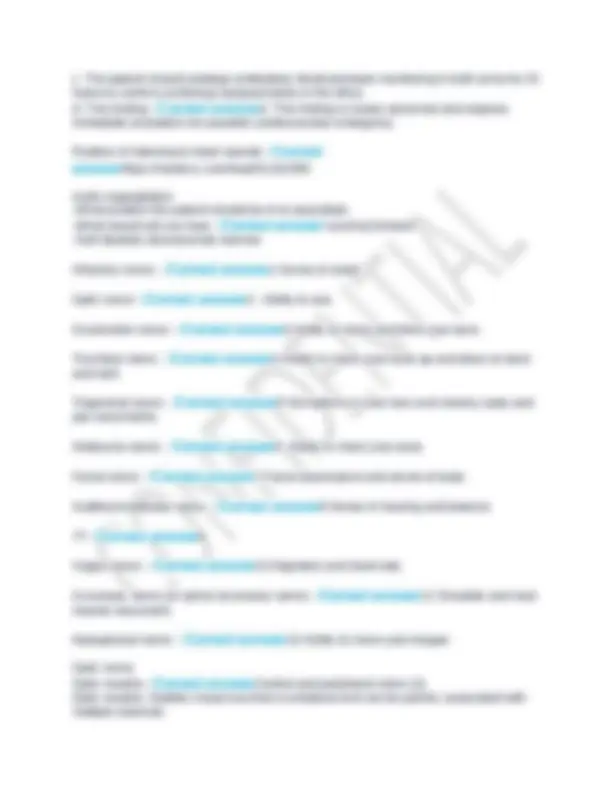
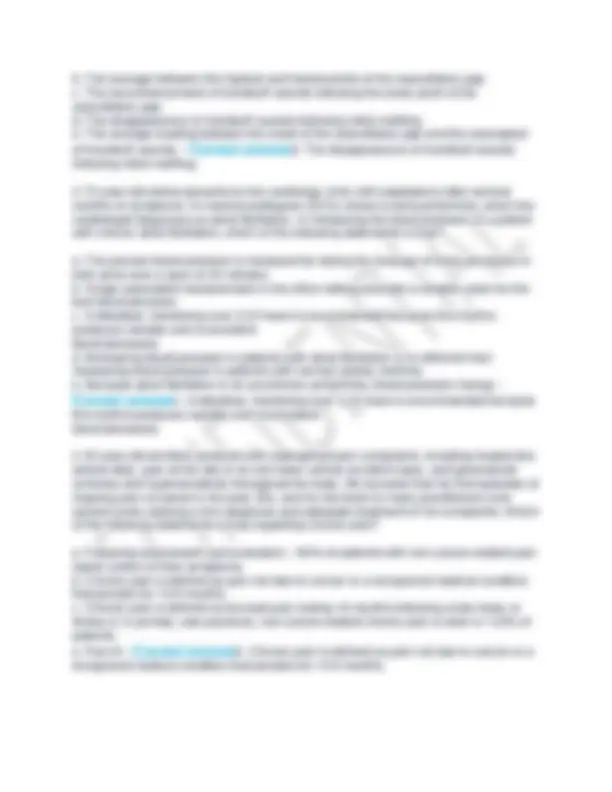
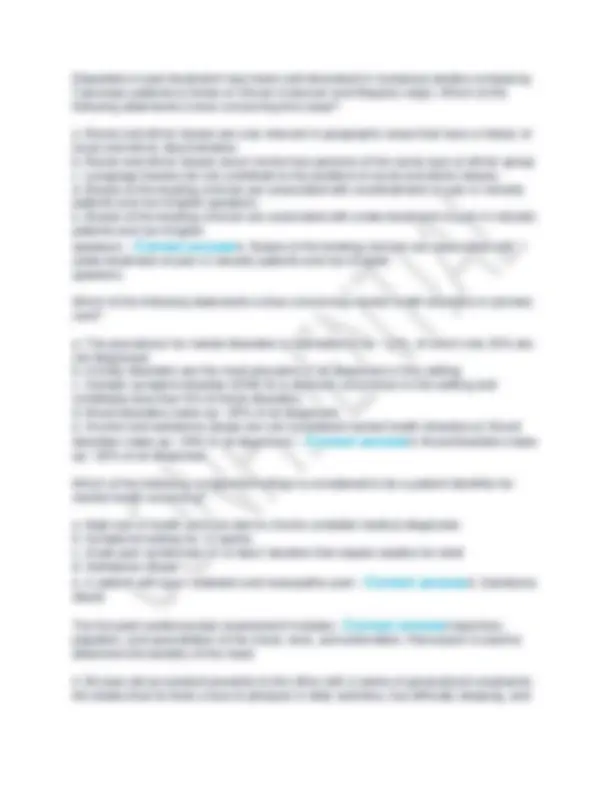
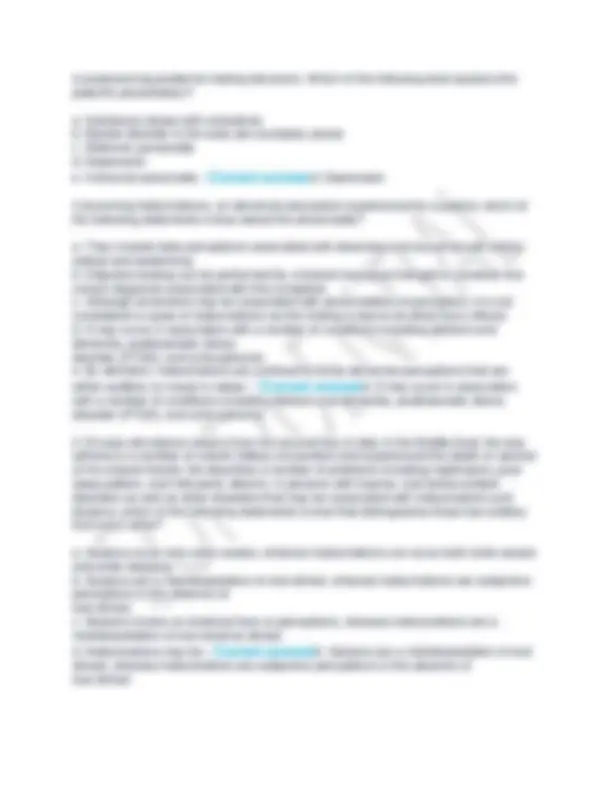

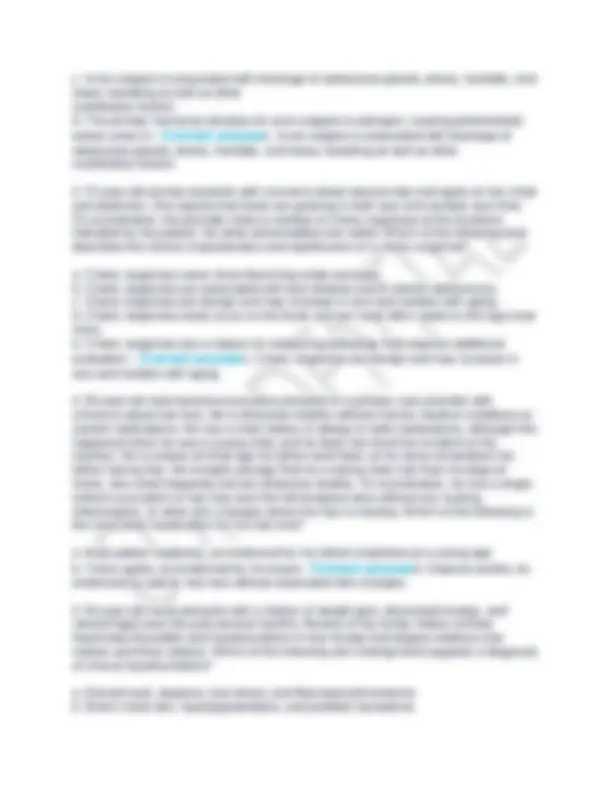
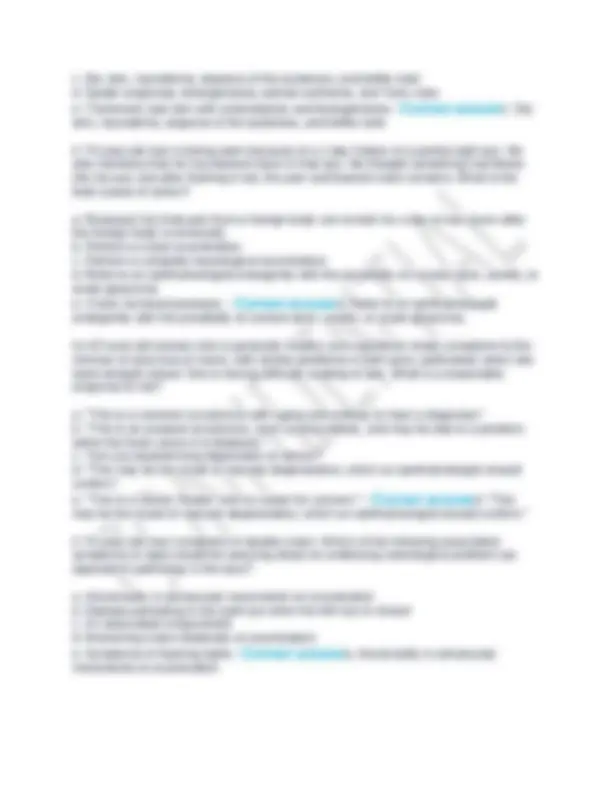
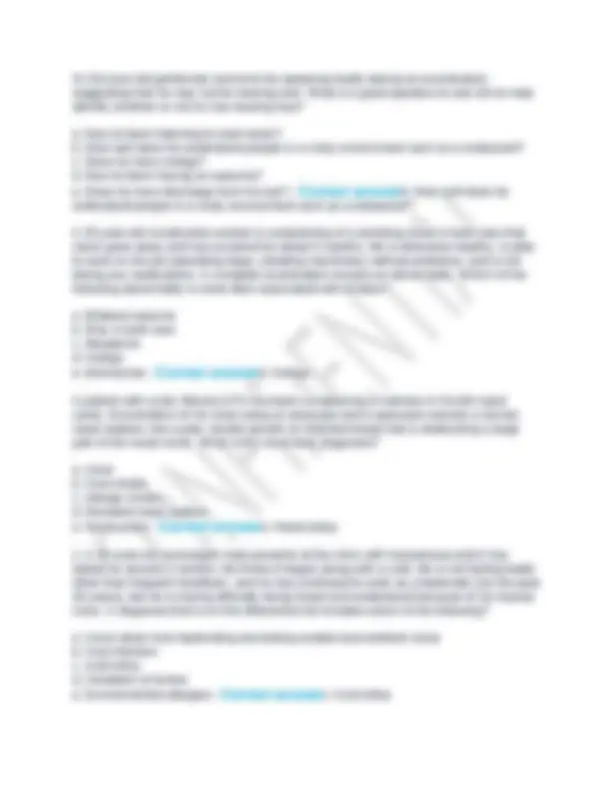
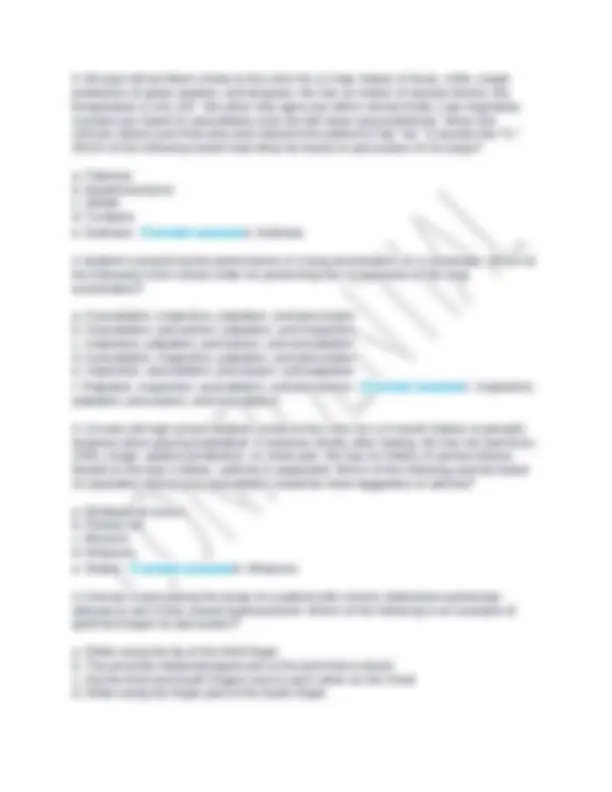
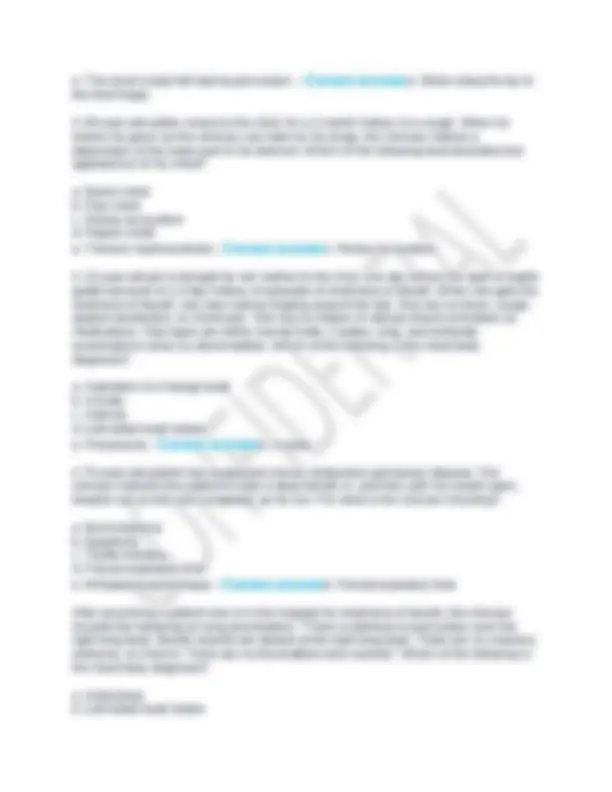
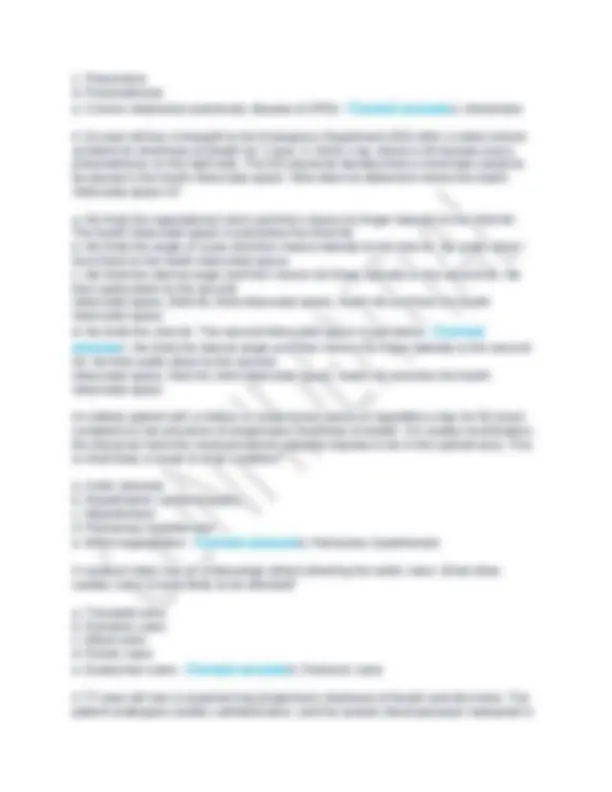
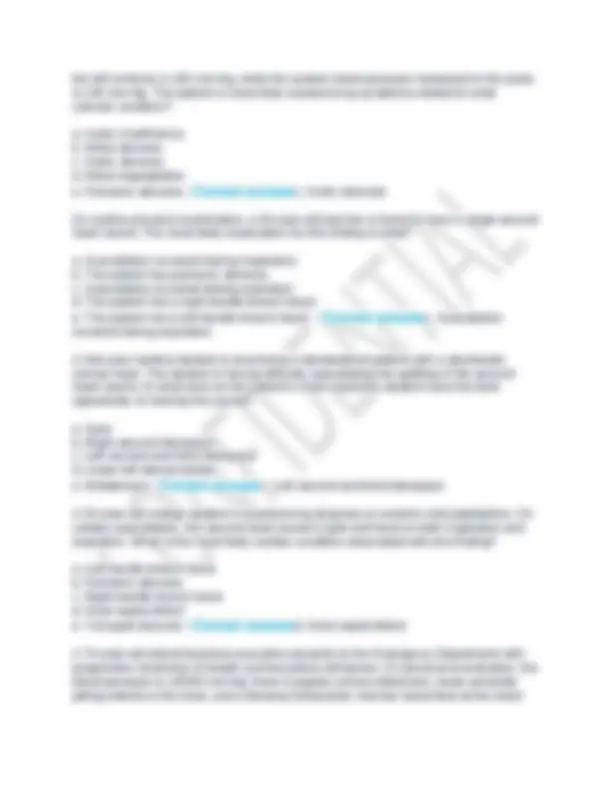
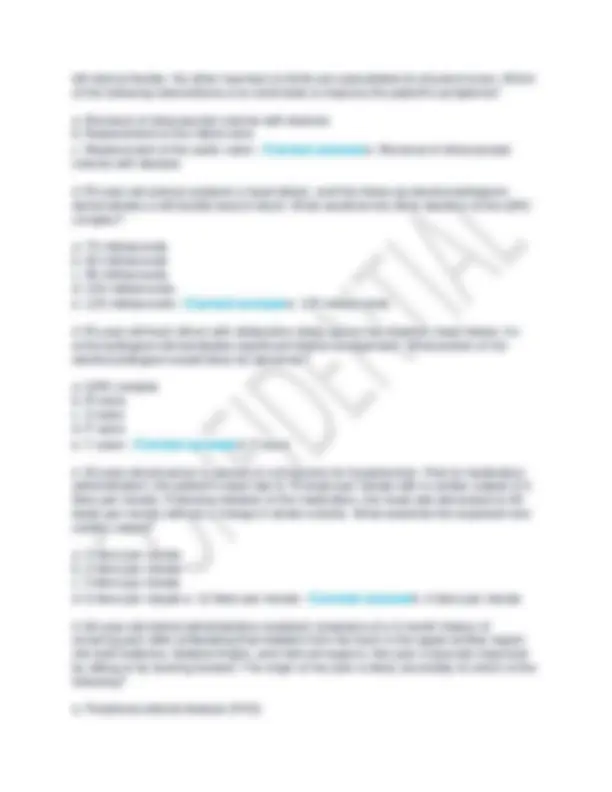
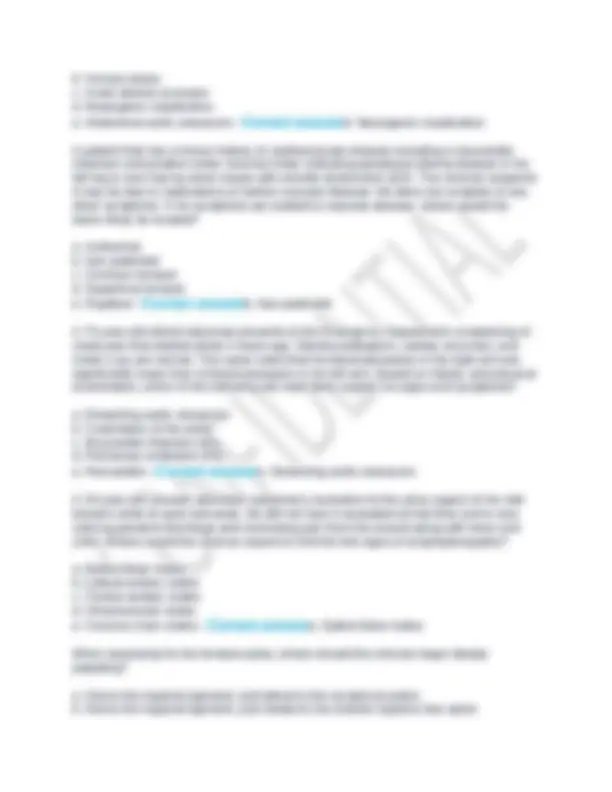
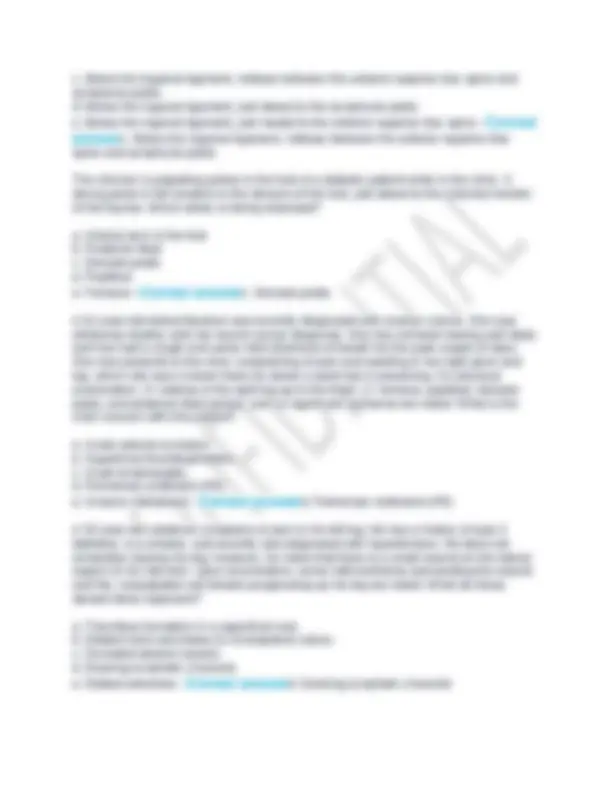
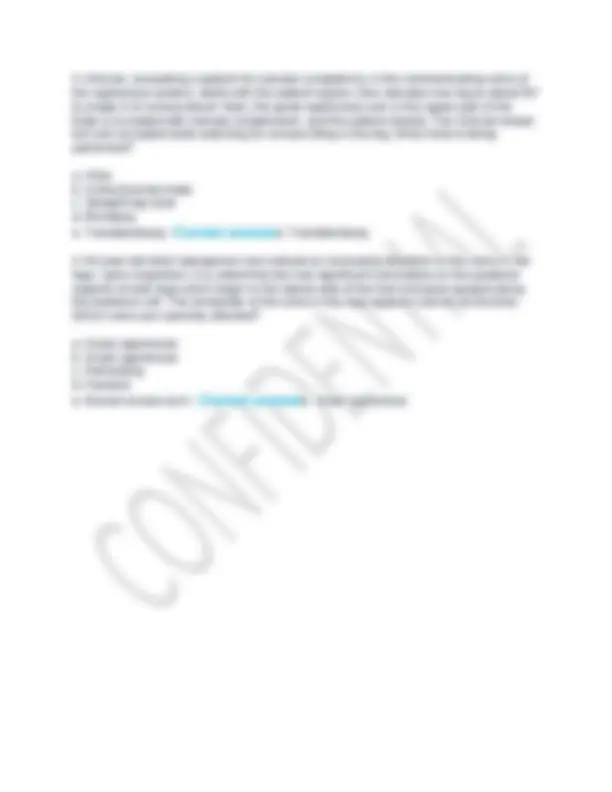


Study with the several resources on Docsity

Earn points by helping other students or get them with a premium plan


Prepare for your exams
Study with the several resources on Docsity

Earn points to download
Earn points by helping other students or get them with a premium plan
Community
Ask the community for help and clear up your study doubts
Discover the best universities in your country according to Docsity users
Free resources
Download our free guides on studying techniques, anxiety management strategies, and thesis advice from Docsity tutors
NR509 2025-2026 update/NR509 / NR 509 Midterm Exam (Latest 2025 / 2026): Advanced Physical Assessment - Chamberlain/GET IT 100% ACCURATE! /GRADED A+
Typology: Exams
1 / 29

This page cannot be seen from the preview
Don't miss anything!






















A 34-year-old male with a history of complex social and medical needs (including current substance abuse) presents to a primary care teaching clinic. The patient has experienced a number of adversarial relationships with prior clinicians, including voluntarily leaving two practices within the previous year and being asked to leave care at a third clinic due to misbehavior. The attending physician desires to utilize the approaches to this patient that are most likely lead to comprehensive care and patient compliance. Which of the following is the most appropriate interview style for the attending physician to use? a. Focusing on the need for immediate diagnostic certainty over personal connection b. Taking charge of the interaction to meet the clinician's desire to acquire diagnostic information c. Following the patient's lead to understand their thoughts, ideas, concerns, and requests
understand their thoughts, ideas, concerns, and requests A 36-year-old female air traffic controller presents to her primary care provider for a routine visit 3 months after losing her spouse to a lengthy battle with a neurodegenerative disease. The patient denies any psychiatric symptoms on review of systems and, in fact, states that she has slept better in the last month than she had in the previous years. She endorses a healthy support system, including the extended family of her deceased spouse, with whom she is still close. She becomes wistful and briefly tearful when speaking of the plans that they had when they first married that were never fulfilled; she then changes the subject rapidly to whether her Pap smear is due. Which of the following is an example of an empathetic response to this patient? a. Assuming that the event caused her to become depressed and expressing the same feeling on behalf of the patient
Recognizing the patient's emotions by asking or confirming how she feels about the event A 19-year-old student of art history presents to clinic after a syncopal (fainting) episode at school. He is notably thin; on a thorough review of his medical history, he admits that
he eats only minimally to maintain a very low body weight that he feels is ideal. He is embarrassed that his issues were discussed by peers after this episode, especially because he believes that this is a problem that is only faced by girls and women. Concerning the two most common eating disorders (anorexia nervosa and bulimia nervosa), which of the following statements is true? a. Men and women are both afflicted, but with a female:male prevalence ratio estimated at ~2:1. b. Both of these eating disorders are associated with a body mass index (BMI) of <17.5. c. Both of these eating disorders are associated with a real or imagined fear of appearing fat. d. Persons with eating disorders are generally easily identified by their appeara -
imagined fear of appearing fat. A 23-year-old physician assistant (PA) student found that she felt nervous when called upon to examine men in her age group. On one occasion, she encountered a young male patient who appeared embarrassed to see her walk into the room. What should the PA do to minimize their mutual discomfort? a. Adjust lighting so it is tangential to the patient's body. b. Explain how the examination will proceed. c. Ask the patient where he comes from. d. Explain that she is a PA student.
examination will proceed. A 17-year-old male presents to a sexually transmitted disease clinic at the behest of his brother, who convinced the patient to attend the clinic after he disclosed that he prefers homosexual partners but is afraid that his last partner may have given him an infection. The patient expresses to the intake nurse that he is unashamed of his sexual orientation and will not stay through the visit if he feels that he is dismissed or discriminated against because of it. The nurse practitioner receives this communication prior to entering the examination room and decides to employ active listening to best connect with the patient at this critical juncture in his care with the clinic. Which of the following is an example of an active listening technique? a. Ignoring visual cues to focus on the patient's exact words b. Setting aside the patient's emotional state to focus on his medical needs
communication to encourage the patient to expand their narrative A 42-year-old female mathematician presents for follow-up care regarding a new diagnosis of systemic lupus erythematosus 6 months ago after a lengthy diagnostic process during which she was debilitated with fatigue and joint pain. Since her diagnosis, she has been minimally compliant with medications and has switched her
a. Providing serial reassurances such as, "Don't worry, you're going to be fine." b. Asking a series of negative questions such as, "You don't have any swelling in your feet, do you?" c. Nonverbally cuing the patient to focus on his narrative regarding a motor vehicle accident d. (MVA) that led to back pain
Moving from open-ended to focused questions A 59-year-old patient presents to his primary care provider with a history of several episodes of sharp epigastric pain. His father died of pancreatic cancer at age 52 years, and the patient recalls to the clinician that, "His pain was just like mine is now ..." The patient then pauses several seconds. The clinician replies, "Just like?" after which the patient restarts his narrative. Which of the following is an example of the interviewing techniques employed by the clinician? a. Clarifying b. Echoing c. Encouraging with continuers d. Eliciting a graded response
A 14-year-old male presents to a new primary care provider after his family relocates to a state. The patient underwent treatment for sarcoma when he was age 11 years, including an above-the-knee amputation. He has learned to successfully navigate with a prosthetic leg and even engage in competitive athletics at school. He does not like to speak of his experience with cancer and often makes up humorous stories to tell new acquaintances about his amputation (such as, "I got bit by a squirrel and they had to amputate."). Although he is very well engaged in most of the visit with the new clinician, when the topic of cancer arises, he demurs to his father, who accompanies him to this appointment. Which of the following statements is most likely to be helpful in cementing the patient's trust in the new provider a. "That sounds like a frightening experience that you are recovering well from."
experience that you are recovering well from." A 29-year-old electrician complains of persistent cough and wheezing, particularly when he exercises. He says he smokes "occasionally" but rarely so much that he needs to purchase cigarettes: "Mostly, I bum them," he says, chuckling. Upon hearing this information, what is the best next step on the part of the clinician? a. Determine the patient's exercise regimen. b. Determine the number of pack-years the patient smokes. c. Conduct a mental status examination. d. Explain the relationship between smoking and cancer.
number of pack-years the patient smokes. A 47-year-old fitness trainer visits the physician assistant (PA) because of skin dryness, night sweats, and irregular menstrual periods. It is the PA's first contact with this patient. The patient notes that "My sex life has really gone downhill lately" and says that she is considering divorcing her husband of 20 years, stating that "He's not a bad guy. I just think that I can do better." In which of the following ways should the clinician proceed? a. Obtain a menstrual history for the previous 6 months. b. Help the patient review the pros and cons of divorce. c. Inform the patient that menopause is a normal part of aging. d. Conduct a breast examination.
menstrual history for the previous 6 months. One important examination technique involves using the third fingers of each hand to determine the health of internal organs. What is the name of this technique? a. Auscultation b. Percussion c. Inspection d. Palpation
The CAGE questionnaire is a short screening examination administered in the office to evaluate for which of the following? a. Alcohol misuse b. Risk for illicit substance abuse c. Likelihood that the patient complaints are "psychosomatic" d. Major depressive disorder
A 53-year-old caterer comes to the clinic for a routine examination. She has type 2 diabetes mellitus, which is well controlled on medication. Her history from her last visit reveals that she smoked one pack of cigarettes a day at that time. The 5 As Model is a useful approach to take with trying to help patients to quit smoking. What is the 5 As Model? a. Admonish, action, available, assess, alleviating factors b. Agitate, assist, alleviating factors, able, action c. Affable, associated manifestations, ask, admonish, available d. Ask, advise, assess, assist, arrange
advise, assess, assist, arrange
A 45-year-old forklift driver presents to the clinic at 4 o'clock in the afternoon complaining of intense substernal chest pain and nausea. He appears pale and sweaty. At work that day, he filled in for an absent co-worker and was asked to perform heavy lifting not normally a part of his job. The physician assistant (PA) questions the patient in detail about his nausea, eating habits, and digestive history. Which of the following steps of clinical reasoning has the PA failed to follow? a. Elicit information about the patient's gastrointestinal (GI) system b. Localize findings anatomically c. Match findings against conditions that could cause them d. Give special consideration to potential life-threatening problems
The positive predictive value of a test is calculated as the number of true positives identified by the test divided by the total positives found by the test. If a novel test for strep throat yields 150 true-positive results and 150 false-positive results, what is the positive predictive value of this test? a. 10% b. 25% c. 50% d. 75%
Location Duration Character Aggravating or alleviating factors Radiation Timing Setting The negative predictive value of a test is calculated as the number of true negatives identified by the test divided by the total negatives found by the test. If a novel test for strep throat yields 85 true-negative results and 15 false-negative results, what is the negative predictive value of this test? a. 10% b. 15% c. 75% d. 85%
A 58-year-old carpenter presents for his annual physical examination. The physician assistant notes a systolic murmur on auscultation of the aorta. However, she does not immediately conclude that this patient has aortic stenosis. Which of the following is the reason that she seeks additional information? a. Systolic murmurs have high sensitivity and high specificity for aortic stenosis. b. Systolic murmurs have low sensitivity and low specificity for aortic stenosis. c. Systolic murmurs have low sensitivity but high specificity for aortic stenosis. d. Systolic murmurs have high sensitivity but low specificity for aortic stenosis.
murmurs have high sensitivity but low specificity for aortic stenosis. A mother brings her 8-year-old daughter to the clinic because she found a tick in the girl's hair and would like her daughter to be tested for Lyme disease. The nurse practitioner (NP) explains that the enzyme-linked immunosorbent assay (ELISA), an early test for Lyme disease, is effective in finding early cases of Lyme disease but can also give positive results in some people who do not have the disease, making additional testing necessary. This means that the ELISA test has which of the following? a. Low sensitivity, high specificity b. High sensitivity, high specificity c. High sensitivity, low specificity d. Low sensitivity, low specificity
specificity A theoretical laboratory test for infection with HIV is known to have high sensitivity. This means that the test has which of the following? a. Good ability to rule in HIV in those who do have HIV b. Good ability to rule out HIV in those who do not have HIV c. High intraobserver reliability d. High interobserver reliability
those who do not have HIV A theoretical new laboratory test for strep throat has high specificity. When a test has high specificity, clinicians can be confident in which of the following aspects? a. If the test result is positive, the patient probably has strep throat. b. If the test result is positive, the patient probably does not have strep throat. c. If the test result is negative, the patient probably has strep throat. d. If the test result is negative, the patient probably does not have strep throat.
c. The patient should undergo ambulatory blood pressure monitoring in both arms for 24 hours to confirm conflicting measurements in the office.
immediate evaluation for possible cardiovascular emergency.
Aortic regurgitation -What position the patient should be in to auscultate
-Soft diastolic decrescendo murmur
and forth
jaw movements.
muscle movement.
Optic nerve
Optic neuritis: Sudden visual loss that is unilateral and can be painful, associated with multiple sclerosis
Feelings, ideas, function, and expectations
problem list
a patient's condition
suspicion for a particular disease
conditions that persists for more than 3 to 6 months, pain lasting more than 1 month beyond the course of an acute illness or injury, or pain recurring at intervals of months or years. Chronic pain is the leading cause of disability and impaired performance at work. Inquire about the effects of pain on the patient's daily activities, mood, sleep, work, and sexual activity. Depressive, somatoform, and anxiety disorders affect the patient's coping strategies and have to be identified in order to effectively treat acute pain, in particular, chronic pain.
print that a person with normal vision could read at 100 ft, the larger the second number the worse the vision. First # indicates the distance from the chart.
the pupil and examine the interior surface of the posterior eye
disc leads to elevated ICP causes intraaxonal edema along the optic nerve leading to engorgement and swelling on the optic disc -Pink, hyperemic, loss of venous pulsations, disc more visible, disc swollen with blurred margins, physiologic cup not visible •Headache, blurred vision, feeling less alert than usual, vomiting, changes in behavior, weakness or problems with moving or talking, lack of energy or sleepiness
b. The average between the highest and lowest points of the auscultatory gap. c. The recommencement of Korotkoff sounds following the lower point of the auscultatory gap. d. The disappearance of Korotkoff sounds following initial muffling. e. The average reading between the onset of the auscultatory gap and the resumption
following initial muffling. A 72-year-old retiree presents to the cardiology clinic with palpitations after several months of symptoms. An electrocardiogram (ECG) shows a tachyarrhythmia, which the cardiologist diagnoses as atrial fibrillation. In measuring the blood pressure of a patient with chronic atrial fibrillation, which of the following statements is true? a. The precise blood pressure is measured by taking the average of three pressures in both arms over a span of 20 minutes. b. Single automated measurement in the office setting provides a reliable value for the true blood pressure. c. Ambulatory monitoring over 2-24 hours is recommended because this rhythm produces variable and inconsistent blood pressures. d. Measuring blood pressure in patients with atrial fibrillation is no different than measuring blood pressure in patients with normal cardiac rhythms. e. Because atrial fibrillation is an uncommon arrhythmia, blood pressure manag -
this rhythm produces variable and inconsistent blood pressures. A 42-year-old architect presents with widespread pain complaints, including headaches almost daily, pain at the site of an old motor vehicle accident injury, and generalized achiness and hypersensitivity throughout the body. He recounts that his first episodes of ongoing pain occurred in his early 20s, and he has been to many practitioners over several years seeking a firm diagnosis and adequate treatment of his complaints. Which of the following statements is true regarding chronic pain? a. Following assessment and evaluation, ~80% of patients with non-cancer-related pain report control of their symptoms. b. Chronic pain is defined as pain not due to cancer or a recognized medical condition that persists for >3-6 months. c. Chronic pain is defined as focused pain lasting >8 months following acute injury or illness.d. In primary care practices, non-cancer-related chronic pain is seen in <10% of patients.
recognized medical condition that persists for >3-6 months.
Disparities in pain treatment have been well described in numerous studies comparing Caucasian patients to those of African American and Hispanic origin. Which of the following statements is true concerning this issue? a. Racial and ethnic biases are only relevant in geographic areas that have a history of racial and ethnic discrimination. b. Racial and ethnic biases never involve two persons of the same race or ethnic group. c. Language barriers do not contribute to the problem of racial and ethnic biases. d. Biases of the treating clinician are associated with overtreatment of pain in minority patients and non-English speakers. e. Biases of the treating clinician are associated with under-treatment of pain in minority patients and non-English
under-treatment of pain in minority patients and non-English speakers. Which of the following statements is true concerning mental health disorders in primary care? a. The prevalence for mental disorders is estimated to be ~10%, of which only 25% are not diagnosed. b. Anxiety disorders are the most prevalent of all diagnoses in this setting. c. Somatic symptom disorder (DSM-5) is distinctly uncommon in this setting and constitutes less than 5% of these disorders. d. Mood disorders make up ~25% of all diagnoses. e. Alcohol and substance abuse are not considered mental health disorders.d. Mood
up ~25% of all diagnoses. Which of the following complaints/findings is considered to be a patient identifier for mental health screening? a. High use of health services due to chronic unstable medical diagnoses b. Symptoms lasting for >2 weeks c. Acute pain syndromes of 10 days' duration that require opiates for relief d. Substance abuse
abuse
palpation, and auscultation of the chest, neck, and extremities. Percussion is used to determine the borders of the heart. A 38-year-old accountant presents to the office with a series of generalized complaints. He relates that he feels a loss of pleasure in daily activities, has difficulty sleeping, and
Abstract thinking is an important component of the human thought process. A person's ability to understand questions that test his or her ability to answer appropriately is dependent upon a number of factors. Which one of the following answers is true in identifying a patient with concrete thinking and a reduced ability to think abstractly? a. An inability to correctly perform serial 7s b. An inability to spell "world" backward c. An inability to name the occupations of common well-known public figures such as the President and Vice President d. An inability to draw a clock correctly including all numbers and make it tell time as requested (i.e., 10:15) e. An inability to discern the similarity between two words (e.g., a cat and a mouse by answering "The cat chases the
(e.g., a cat and a mouse by answering "The cat chases the mouse.") Concerning a patient that may demonstrate a diagnosis of aphasia, which of the following statements is true? a. It involves a loss of the voice or a slurring or hoarseness of speech secondary to pathology of the larynx or its nerve supply. b. It is best characterized by slurred speech with an associated defect in language control. c. It is best characterized by involuntary, rhythmic, repetitive movements involving the tongue and jaws making speech difficult to comprehend. d. The ability to write a full correct sentence does not rule out the presence of aphasia in a patient.
It is defined as an inability to produce or understand language. A 42-year-old fair-skinned woman of Irish origin presents with an abnormal skin growth that was first noted 7 years ago. On examination, a 2 × 3-cm lesion is noted over her left bicep. Which of the following historical elements most increases the suspicion that the lesion is malignant? a. No evolution in size since onset, but mild intermittent pruritus over the last 2 yearsb. No evolution in size since onset, but uniformly darkly pigmented color c. Minimal but discernible increase in size over the past 6 months d. Presence of similar pinkish tan lesions on the sun-exposed areas including the face and hands
A 17-year-old woman presents with her parents to her primary care provider. She desires to utilize a tanning facility ahead of an upcoming event. Her parents have heard
that this is a dangerous practice, although the tanning facility insists it is safe without risk of skin cancer in the future after tanning. Which of the following is true regarding ultraviolet (UV) light exposure and subsequent risk of skin cancer? a. Chronic sun exposure confers greater risk for skin cancer than intermittent intensive exposure. b. Tanning beds and sunlamps do not increase risks of skin cancer as they utilize UV wavelengths that are not carcinogenic. c. Water-resistant sunscreens confer no advantage over water-soluble products. d. Targeted messaging and practitioner reinforcement in primary care amplify sun- protective behaviors. e. Sunscreen with a sun protective factor (SPF) of 15 blocks ~50% of UV-B light. -
care amplify sun-protective behaviors. A 52-year-old male presents for an annual examination. He discloses on review of family history that his father has died of skin cancer since his last visit. He personally has had two actinic keratoses frozen and has further lesions that require evaluation today. He is very concerned about his personal and family history and would like to know more about the potential for skin cancer to spread and become a dangerous condition. Which of the following skin lesions is the least likely to metastasize? a. Squamous cell carcinoma (SCC) b. Actinic keratosis c. Melanoma d. Seborrheic keratosis
A 62-year-old manual laborer presents to an annual physical examination with concerns about skin cancer screening. He does not have any lesions of concern but was recently told by a friend that he should have his skin checked by a doctor yearly. What is the best advice for this patient according to the U.S. Preventive Services Task Force (USPSTF) recommendations on skin cancer screening from 2015? a. The USPSTF recommends that all individual age >50 years be screened yearly for skin cancer regardless of risk factors. b. The USPSTF recommendations mirror those of the American Cancer Society (ACS) and American Academy of Dermatologists (AAD) in recommending and annual skin cancer screening for patients age >50 years. c. The USPSTF recommends skin cancer screening only in sun-exposed areas of fair- skinned individuals every 6 months. d. The USPSTF recommends focused screening of individuals with a history of dysplasti
c. Acne vulgaris is associated with blockage of sebaceous glands, stress, humidity, and heavy sweating as well as other contributory factors d. The primary hormonal stimulus for acne vulgaris is estrogen, causing preferentially
sebaceous glands, stress, humidity, and heavy sweating as well as other contributory factors A 72-year-old woman presents with concerns about several ruby-red spots on her chest and abdomen. She reports that these are growing in both size and number over time. On examination, the provider notes a number of cherry angiomas at the locations indicated by the patient. No other abnormalities are noted. Which of the following best describes the clinical characteristics and significance of a cherry angioma? a. Cherry angiomas never show blanching under pressure. b. Cherry angiomas are associated with liver disease and B vitamin deficiencies. c. Cherry angiomas are benign and may increase in size and number with aging. d. Cherry angiomas rarely occur on the trunk and are most often noted on the legs near veins. e. Cherry angiomas are a marker for underlying pathology that requires additional
size and number with aging. A 28-year-old male business executive presents to a primary care provider with concerns about hair loss. He is otherwise healthy without chronic medical conditions or current medications. He has a chart history of allergy to sulfa medications, although this happened when he was a young child, and he does not recall the incident or the reaction. He is unsure at what age his father went bald, as he never remembers his father having hair. He remarks jokingly that he is losing more hair than his dogs at home, who shed frequently but are otherwise healthy. On examination, he has a single uniform oval patch of hair loss over the left temporal area without any scaling, inflammation, or other skin changes where the hair is missing. Which of the following is the most likely explanation for his hair loss? a. Male pattern baldness, as evidenced by his father's baldness at a young age
evidenced by patchy hair loss without associated skin changes A 33-year-old nurse presents with a history of weight gain, decreased energy, and menorrhagia over the past several months. Review of her family history reveals Hashimoto thyroiditis and hypothyroidism in four female first-degree relatives (her mother and three sisters). Which of the following skin findings best supports a diagnosis of clinical hypothyroidism? a. Discoid rash, alopecia, oral ulcers, and Raynaud phenomenon b. Warm moist skin, hyperpigmentation, and pretibial myxedema
c. Dry skin, myxedema, alopecia of the eyebrows, and brittle nails d. Spider angiomas, telangiectasia, palmar erythema, and Terry nails
skin, myxedema, alopecia of the eyebrows, and brittle nails A 74-year-old man is being seen because of a 1-day history of a painful right eye. He also mentions that he has blurred vision in that eye. He thought something had blown into his eye, but after flushing it out, the pain and blurred vision remains. What is the best course of action? a. Reassure him that pain from a foreign body can remain for a day or two (even after the foreign body is removed). b. Perform a vision examination. c. Perform a complete neurological examination. d. Refer to an ophthalmologist emergently with the possibility of corneal ulcer, uveitis, or acute glaucoma.
emergently with the possibility of corneal ulcer, uveitis, or acute glaucoma. An 87-year-old woman who is generally healthy and cognitively sharp complains to the clinician of slow loss of vision, with similar problems in both eyes, particularly when she looks straight ahead. She is having difficulty reading of late. What is a reasonable response to her? a. "This is a common occurrence with aging and unlikely to have a diagnosis." b. "This is an unusual occurrence, even among elderly, and may be due to a problem within the brain (since it is bilateral)." c. "Are you experiencing depression or stress?" d. "This may be the onset of macular degeneration, which an ophthalmologist should confirm."
may be the onset of macular degeneration, which an ophthalmologist should confirm." A 70-year-old man complains of double vision. Which of the following associated symptoms or signs would be worrying about an underlying neurological problem (as opposed to pathology in the eye)? a. Abnormality in extraocular movements on examination b. Diplopia persisting in the right eye when the left eye is closed c. An associated conjunctivitis d. Worsening vision bilaterally on examination
movements on examination